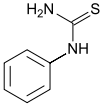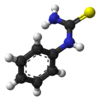Phenylthiocarbamide
| |||
| Names | |||
|---|---|---|---|
| IUPAC name
Phenylthiourea | |||
| Other names
N-Phenylthiourea; 1-Phenylthiourea | |||
| Identifiers | |||
| 103-85-5 | |||
| ChEBI | CHEBI:46261 | ||
| ChemSpider | 589165 | ||
| |||
| Jmol-3D images | Image | ||
| MeSH | Phenylthiourea | ||
| PubChem | 676454 | ||
| |||
| UNII | 6F82C6Q54C | ||
| Properties | |||
| Molecular formula |
C7H8N2S | ||
| Molar mass | 152.22 g·mol−1 | ||
| Appearance | White to slightly yellow powder | ||
| Density | 1.294 g/cm3 | ||
| Melting point | 145 to 150 °C (293 to 302 °F; 418 to 423 K) | ||
| Soluble in boiling water | |||
| Hazards | |||
| EU classification | | ||
| NFPA 704 | |||
| LD50 (Median lethal dose) |
3 mg/kg (oral, rat) | ||
| Except where noted otherwise, data is given for materials in their standard state (at 25 °C (77 °F), 100 kPa) | |||
| | |||
| Infobox references | |||
Phenylthiocarbamide (PTC), also known as phenylthiourea (PTU), is an organosulfur thiourea containing a phenyl ring.
It has the unusual property that it either tastes very bitter or is virtually tasteless, depending on the genetic makeup of the taster. The ability to taste PTC is a dominant genetic trait.
PTC also inhibits melanogenesis and is used to grow transparent fish.[1]
About 70% of people can taste PTC, varying from a low of 58% for indigenous peoples of Australia and New Guinea to 98% for indigenous peoples of the Americas.[2] One study has found that non-smokers and those not habituated to coffee or tea have a statistically higher percentage of tasting PTC than the general population.[3][4] PTC does not occur in food, but related chemicals do, and food choice is related to a person's ability to taste PTC.[3][5]
History
The genetic taste phenomenon of PTC was discovered in 1931 when a DuPont chemist named Arthur Fox accidentally released a cloud of a fine crystalline PTC. A nearby colleague complained about the bitter taste, while Fox, who was closer and should have received a strong dose, tasted nothing. Fox then continued to test the taste buds of assorted family and friends, setting the groundwork for future genetic studies. The genetic correlation was so strong that it was used in paternity tests before the advent of DNA matching.[6]
In 1976, a remarkable inverse relationship between taster status for PTC and for a bitter component of the fruit of the tree Antidesma bunius was discovered.[7] Research on the implications still continues.
Some chimpanzees share the ability to taste PTC. However, chimpanzee PTC tasting relies on a different taste receptor than human tasting, suggesting that the ability evolved independently in both species.[8]
Role in taste
There is a large body of evidence linking the ability to taste thiourea compounds and dietary habits. Much of this work has focused on 6-propyl-2-thiouracil (PROP), a compound related to PTC that has lower toxicity.[2] A supertaster has more of an ability to taste PTC. On the other hand, heavy cigarette smokers are more likely to have high PTC and PROP thresholds (i.e. are relatively insensitive).
Ability to taste PTC may be correlated with a dislike of plants in the Brassica genus, presumably due to chemical similarities.
Genetics
There are three SNPs (single nucleotide polymorphisms) along the gene that may render its proteins unresponsive.[9] There is conflicting evidence as to whether the inheritance of this trait is dominant or incomplete dominant. Any person with a single functional copy of this gene can make the protein and is sensitive to PTC. Some studies have shown that homozygous tasters experience a more intense bitterness than people that are heterozygous; other studies have indicated that another gene may determine taste sensitivity.
The frequency of PTC taster and non-taster alleles vary in different human populations.[10]
Chimpanzees and orangutans also vary in their ability to taste PTC, with the proportions of tasters and non-tasters similar to that in humans.[11]
See also
References
- ↑ Karlsson, Johnny; von Hofsten, Jonas; Olsson, Per-Erik (2001). "Generating Transparent Zebrafish: A Refined Method to Improve Detection of Gene Expression During Embryonic Development". Marine Biotechnology 3 (6): 522–527. doi:10.1007/s1012601-0053-4. PMID 14961324.
- ↑ 2.0 2.1 Kim U, Wooding S, Ricci D, Jorde LB, Drayna D (2005). "Worldwide haplotype diversity and coding sequence variation at human bitter taste receptor loci". Human Mutation 26 (3): 199–204. doi:10.1002/humu.20203. Retrieved 29 April 2015.
- ↑ 3.0 3.1 Fischer, R., Griffin, F. and Kaplan, A. R. (1963). "Taste thresholds, cigarette smoking, and food dislikes". Medicina experimentalis. International journal of experimental medicine 9: 151–67. doi:10.1159/000135346. PMID 14083335.
- ↑ Kaplan AR, Glanville EV, Fischer R (1964). "Taste thresholds for bitterness and cigarette smoking". Nature 202 (4939): 1366. doi:10.1038/2021366a0. PMID 14210998.
- ↑ Forrai G, Bánkövi G (1984). "Taste perception for phenylthiourea and food choice—a Hungarian twin study". Acta Physiol Hung 64 (1): 33–40. PMID 6541419.
- ↑ Lee Phillips M (15 July 2003). "Scientists Find Bitter Taste Gene". Retrieved 5 December 2009.
- ↑ Henkin, R.I. and W.T. Gillis (1977). "Divergent taste responsiveness to fruit of the tree Antidesma bunius". Nature 265 (5594): 536–537. doi:10.1038/265536a0. PMID 834304.
- ↑ Wooding, Stephen; Bufe, Bernd; Grassi, Christina; Howard, Michael T.; Stone, Anne C.; Vazquez, Maribel; Dunn, Diane M.; Meyerhof, Wolfgang et al. (2006). "Independent evolution of bitter-taste sensitivity in humans and chimpanzees". Nature 440 (7086): 930–4. doi:10.1038/nature04655. PMID 16612383.
- ↑ Kim UK, Jorgenson E, Coon H, Leppert M, Risch N, Drayna D (2003). "Positional cloning of the human quantitative trait locus underlying taste sensitivity to phenylthiocarbamide". Science 299 (5610): 1221–1225. doi:10.1126/science.1080190. PMID 12595690.
- ↑ Fareed, M.; Shah, A.; Hussain, R.; Afzal, M. (2012). "Genetic study of phenylthiocarbamide (PTC) taste perception among six human populations of Jammu and Kashmir (India)". Egypt J Med Hum Genet 13 (2): 161. doi:10.1016/j.ejmhg.2012.01.003.
- ↑ Fisher, Ford and Huxley (1939). Nature 144: 750. Missing or empty
|title=(help)
External links
- Dennis Drayna's home page. Drayna has done extensive studies of PTC in various populations
- Population Study and Applications Using PTC Paper
- Classroom activity description using PTC paper
- Online 'Mendelian Inheritance in Man' (OMIM) 171200 Thiourea tasting


